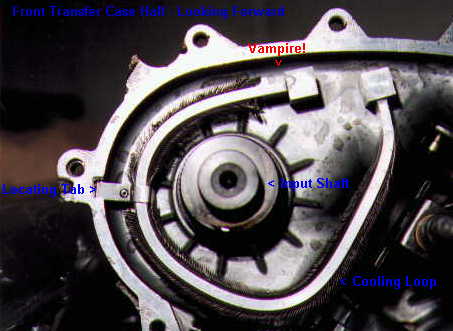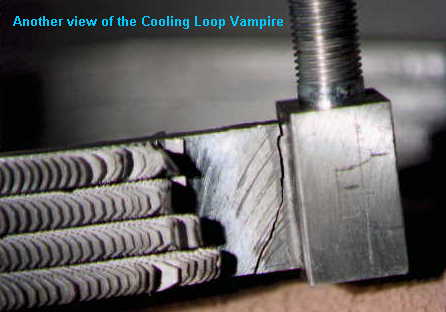| Forum | Marketplace | Knowledge Base | | H1 site | H2 site | H3 site | |
The Hummer Knowledge Base
|
by Scott Weiser If you are unlucky, lurking in the dark, oily recesses of your HUMMER's transfer case lies the ATF Vampire, waiting to suck the life out of your transmission! If your Vampire awakens, it can destroy your transmission and contaminate your differentials, geared hubs and entire vent system. If you are not vigilant about keeping track of your transmission fluid level, the first sign you may notice is delayed shifts and slipping of your transmission. It's also possible that the Vampire could awaken at high speeds and destroy your transmission before you ever notice a low ATF condition! The ONLY way you can prevent damage is to check your ATF level frequently...very frequently. You should become accustomed to how your HUMMER reacts to different types of driving, and how much ATF fluid is normally used over a given period. If you tow heavy trailers or drive cross-country at high speeds, you will have to check and get used to how much fluid you will need to replenish under normal conditions. If you notice a sudden drop in ATF level, more than is normal, you must take action to determine what is happening and where the fluid is going IMMEDIATELY. If you put it off, then the Vampire may also suck the money out of your wallet! First, you should frequently check the fluid level in the transfer case. Follow the directions in the owner's manual for checking transfer case fluid, which, just coincidentally, is the same Dextron III used in the transmission. The fluid level should be level with the bottom of the oil drain plug threads. Some small drips may occur if your vehicle is not level, but if you find excessive levels of ATF in the transfer case, and the fluid is running out of the drain hole in quantity, you should immediately suspect that you have been infested with a Vampire. Also, if you have not already modified the notorious transfer case rubber plug, you may find fluid coming out of this hole if the transfer case becomes over-full due to a Vampire. (I'll explain this shortly) One absolute indicator of the Vampire is the presence of AFT fluid in the air cleaner housing, geared hubs, or differentials. If you notice any red ATF fluid in these places, then your Vampire is active, and you should stop driving your vehicle until you fix the problem. We'll discuss field-expedient repairs later. First, let's take a look at the Transfer Case Cooling Loop and identify the Vampire!
 The T-case cooler loop is an aluminum assembly manufactured as a curved rectangular tube about 1 inch wide by 1/4 inch thick. The hollow rectangular tube is bent in a rough circle and lies along the inside of the forward half of the transfer case and surrounds the input shaft, below (forward of) the main gear and drive chain. The fins on the tube are not soldered, but are machined out of the tubing metal itself. The tube is soldered (NOT welded) at each end to an aluminum fitting which protrudes through the housing of the T-case at a 90 degree angle to the loop, and creates the nipples for attaching the oil lines. The base of the nipple is threaded to take the seal and nut, and the body of the fitting inside the T-case is a hollow cube about 3/4 x 3/4 x 1 1/4, with the tube ends being welded to one flat face. About 1/3 of the circumference around is the Locating Tab, which is an aluminum strap bent around the tube, squashing some fins, which forms a tab which is supposed to fit into a notch milled in the mating surface of the T-case sections. This tab is supposed to position and support the loop.

Here is the ATF Vampire! Inspection reveals that the square tube is cracked completely across one wide face of the tube and down both short faces so that only the inside wide face of the loop remains attached to the inlet/outlet adapter. The crack begins within the soldered joint where the tube meets the adapter. Note that the crack appears to follow the milling marks where it moves away from the solder joint. Pressure in the transmission oil cooling system pumps ATF fluid out through this crack (opened up a bit for clarity) into the transfer case and then into the vent system. Your HUMMER transmission pumps ATF through a cooling loop which goes through the transmission oil cooler at the radiator, comes back to the transfer case, is circulated through the transfer case cooling loop and then back to the transmission. The transfer case cooling loop transfers heat from the transfer case lubricant to the transmission lubricant through the aluminum fins on the cooling loop. While the transfer case has an oil pump to keep the gears oiled, it is a non-pressurized system. The transmission fluid cooling circuit operates under pressure. When the Vampire strikes, which is to say when the transfer case cooling loop cracks, the transmission oil is pumped into the transfer case, and from there into the vent system, hubs, differentials and air cleaner. If you have not sealed the infamous "rubber plug" hole in your transfer case (see the HML FAQ for information on how to do this), the excess transmission fluid may blow out the rubber plug and be pumped overboard instead of into the vent system. This is actually preferable, (from the Vampire-detection standpoint anyway) because you will be much more likely to notice puddles of ATF fluid under your car than low ATF fluid level in the transmission, since many people ignore this vital part of the service/maintenance routine. If the plug doesn't blow, or if you have sealed this hole tightly, then you will not know you have been infested until you notice low fluid or slippage. In any event, you soon have no ATF in your transmission, and it will be quickly destroyed. The rate of fluid loss is dependent upon the size of your Vampire, which probably starts small and gets bigger over time.

Another view of the Vampire!
|
